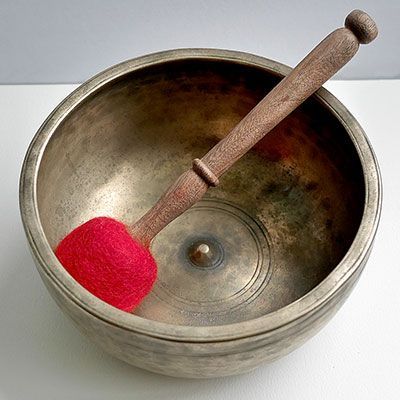7-Metal Singing Bowls – Fact or Fiction?

It is a common belief that the seven metals astrologically associated with the seven (then known) planets or celestial bodies were combined in the bowl-makers alchemical smelting pot to make an antique singing bowl. The seven metals and their planetary associations are Gold (Sun), Silver (Moon), Copper (Venus), Iron (Mars), Tin (Jupiter), Mercury/Quicksilver (Mercury) and Lead (Saturn) all of which feature heavily in alchemical symbolism.
This folklore ‘fact’ is repeated by practically every bowl seller one meets, whether in Kathmandu or elsewhere in the world, and it is particularly rife on the web. It’s a claim that contributes much to the legendary status of antique singing bowls, especially when silver and gold are routinely mentioned as ingredients (a similar claim is made for the antique bronze keys in Balinese gamelan instruments). Whilst this belief may be rooted in fact, and some old hand-beaten bowls might contain seven metals or more, there is scant scientific evidence of the seven-metal bowl today. Popular folklore also claims that the iron component found in some Tibetan bowls comes from sacred ‘sky metal’…meteorite fragments found in the Himalayan mountains, but again there appears to be little factual evidence to support this. But once more it adds to singing bowl mystique.
So if singing bowls are not made of seven metals, what are they made of? The answer is a bronze alloy of copper and tin. When these two metals are smelted together they form an alloy that is harder than iron and more resistant to corrosion, and when mixed in a ratio of approximately 80 parts of copper to 20 parts of tin they result in a type of bronze known as bell metal. This is a particularly sonorous alloy that has been used in the manufacture of high-quality bronze bells, bowls and gongs throughout Asia for countless centuries. It should not be surprising to learn therefore, that the vast majority of antique singing bowls are made from bell-metal bronze, particularly as they are in fact a type of inverted bell, without a tongue or crown, and are sometimes referred to as resting or standing bells. Some scientific studies have found tiny quantities of other metals present, particularly iron, but one metallurgical analysis of more than 100 old singing bowls revealed that they were made from just two metals, copper and tin. However, the precise ratio of one metal to the other is clearly a movable feast as can be seen in the colour and weight differences between antique bowls.
It is interesting to note that the belief in the seven metal singing bowl including silver and gold, be it fact or fiction, has found new life among some of today’s Indian and Nepalese traditional bowl-makers who now produce five, six and seven-metal hand-beaten bowls to order. It seems that the 7-metal singing bowl is alive and well after all!